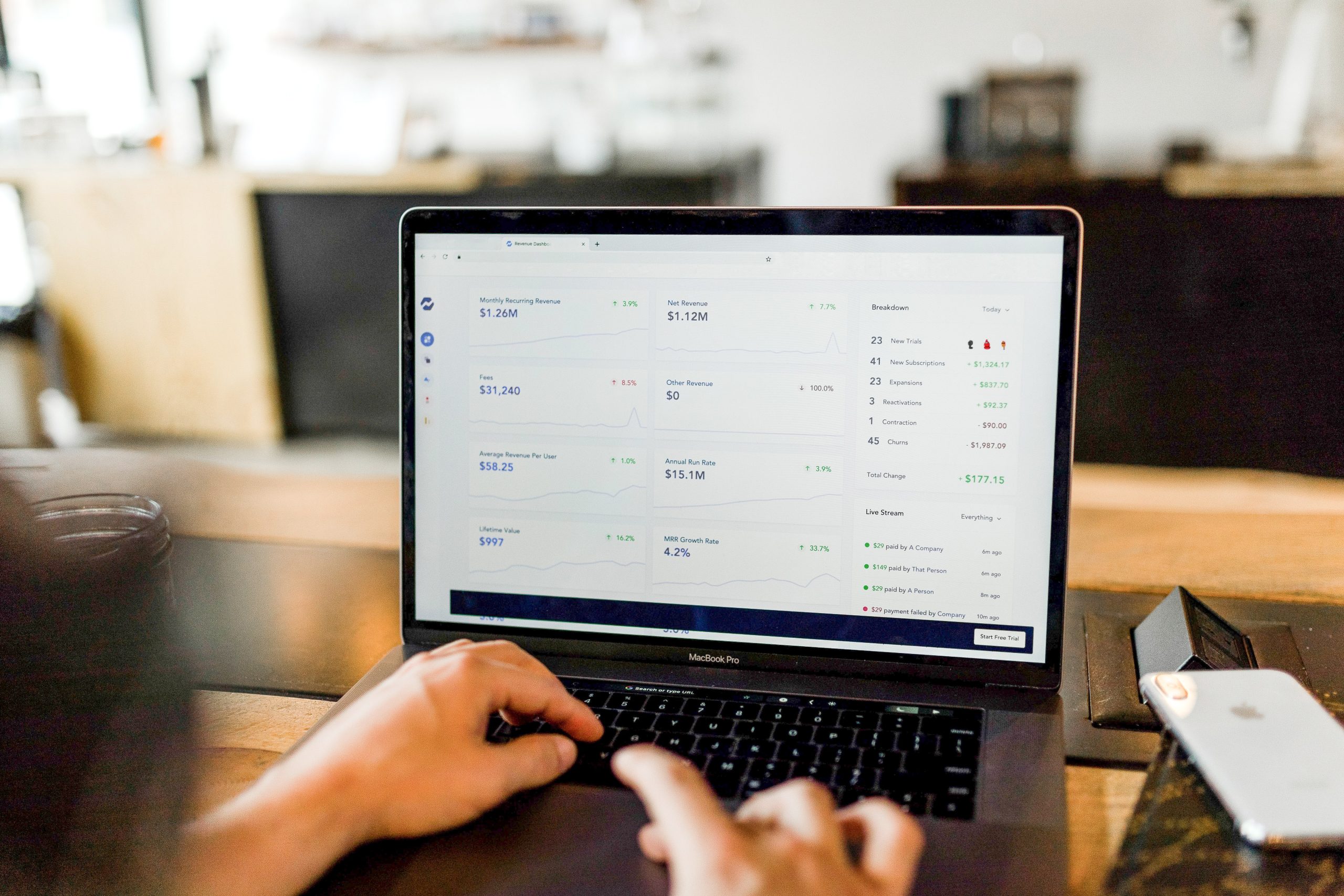If you’ve ever wondered whether your paid ads are truly delivering value—or just draining your budget—you’re not alone. With digital advertising becoming increasingly competitive, Pay-Per-Click (PPC) campaigns offer one of the fastest, most measurable ways to get in front of your target audience and drive real business results.
But here’s the catch: it’s not just about getting clicks. It’s about getting the right clicks, from the right people, at the right time—and making sure they convert.
In this guide, we’ll show you how to build and optimize PPC campaigns that don’t just generate traffic, but generate ROI. From goal-setting and targeting to ad copy, landing pages, and smart bidding strategies, this is your blueprint for getting more out of every dollar you spend.
What Is PPC Advertising?
PPC (Pay-Per-Click) advertising is a digital marketing strategy where advertisers bid on keywords and pay a fee each time their ad is clicked. It offers instant exposure on search engines and other platforms, allowing businesses to appear prominently when potential customers are actively looking for relevant products or services.
This approach provides a high level of control, as you decide how much to spend, who sees your ads, and what message they receive. With precise targeting options, PPC lets businesses engage specific demographics based on location, device, behavior, and search intent—making it a powerful tool for reaching the right audience at the right time.
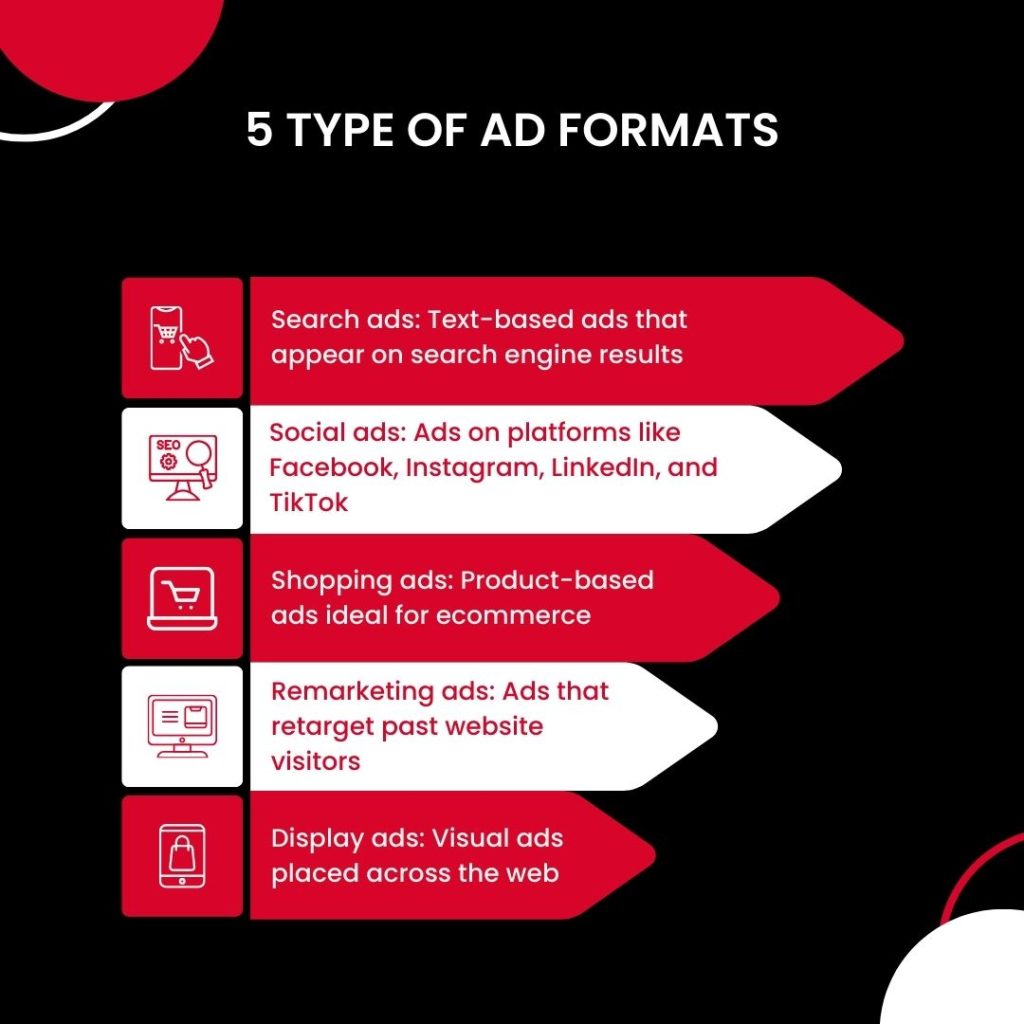
PPC is ideal for businesses that want to:
- Get immediate visibility in search results
- Target users based on specific keywords, location, interests, and more
- Track ROI down to each click and conversion
It encompasses several types of ad formats:
- Search ads: Text-based ads that appear on search engine results
- Display ads: Visual ads placed across the web
- Shopping ads: Product-based ads ideal for ecommerce
- Remarketing ads: Ads that retarget past website visitors
- Social ads: Ads on platforms like Facebook, Instagram, LinkedIn, and TikTok
When executed effectively, PPC becomes one of the most scalable, measurable, and controllable digital advertising tactics in your arsenal. You’re able to generate immediate traffic, test new offers quickly, and gather actionable data that can inform other areas of your marketing strategy, from SEO and content creation to product development and pricing.
In addition to offering control and precision, PPC advertising provides measurable, immediate results—especially useful for new campaigns, promotions, or launches where speed to market is critical. You can start seeing traffic the moment your ads go live, making PPC a powerful tool for testing messaging, validating offers, and ramping up sales quickly.
While SEO builds long-term visibility and trust, PPC helps businesses skip the line and appear at the top of search results instantly. It’s particularly beneficial for competitive markets, seasonal promotions, or when launching a new product or service that doesn’t yet rank organically.
Why ROI Matters in PPC Advertising
Return on Investment (ROI) is the most important success metric in any PPC campaign because it goes beyond surface-level metrics like impressions or clicks. A campaign might generate a high volume of traffic, but unless those visitors take meaningful actions—such as making a purchase, booking a call, or signing up for a service—your budget is being spent with little actual return.
Optimizing for ROI means shifting the focus from quantity to quality. It’s about delivering ads to the right audience at the right moment and presenting them with a compelling offer that leads to a measurable outcome.
Businesses that make ROI their guiding principle in PPC campaigns benefit by:
- Lowering cost-per-acquisition (CPA): Smart targeting and bidding mean fewer wasted clicks and more efficient use of budget.
- Identifying profitable audiences and keywords: Tracking ROI at the keyword and audience level allows you to double down on what’s working.
- Refining ad spend toward high-performing segments: Instead of spreading budget thin, successful campaigns reallocate spend to the ads and audiences that generate conversions.
- Generating sustainable business growth: Campaigns optimized for ROI fuel long-term performance by producing consistent, scalable results.
When PPC campaigns are executed with ROI as the central focus, they can become one of the most reliable and cost-effective tools in a company’s digital marketing toolbox.
Step-by-Step Guide to Maximize PPC ROI
Step 1: Set SMART Goals
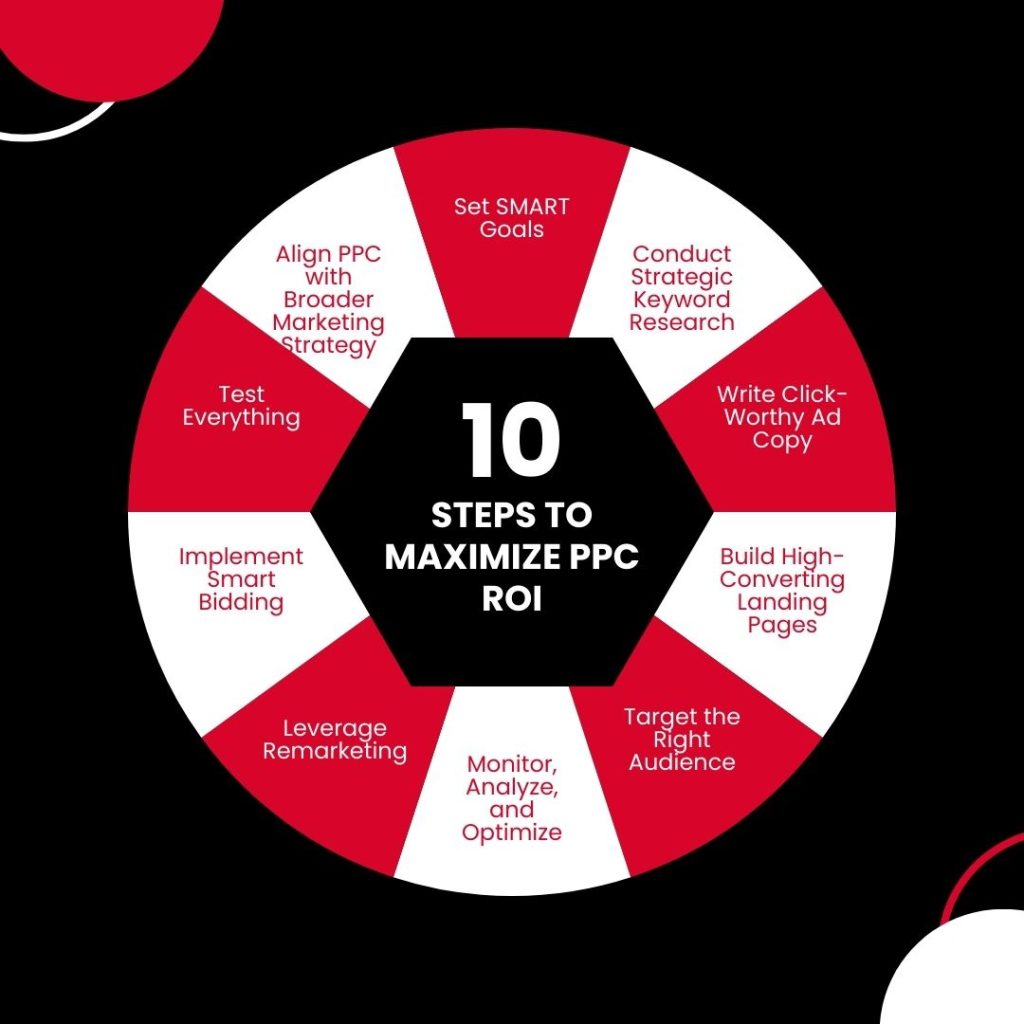
Every PPC campaign needs a clearly defined objective. Without a specific outcome in mind, it becomes nearly impossible to measure success or guide your campaign effectively. SMART goals help create structure and accountability, ensuring your team stays aligned and focused throughout the campaign lifecycle.
These goals should be:
- Specific: Define exactly what you want to achieve—whether it’s increasing leads, boosting online sales, or driving foot traffic to a physical location.
- Measurable: Include quantifiable metrics so you can track progress over time and know when your goals have been met.
- Achievable: Ensure your goals are realistic based on your available budget, resources, and market conditions.
- Relevant: Your PPC goals should support broader business objectives, such as expanding into a new region or launching a new service.
- Time-bound: Set deadlines for achieving your goals so you can assess performance within a defined period and make timely adjustments.
Examples:
- Generate 50 qualified leads in 30 days
- Increase online orders by 20% in 3 months
- Reduce CPA by 15% in Q2
Clear goals keep your campaigns focused and easier to optimize.
Step 2: Conduct Strategic Keyword Research
Keywords are the foundation of PPC. Your entire campaign’s success hinges on selecting the right terms that align with your audience’s intent and your business objectives. Without proper keyword research, you risk targeting terms that drive traffic but fail to convert—or worse, waste your budget on irrelevant clicks.
Use tools like Google Keyword Planner, Ahrefs, or SEMrush to:
- Find long-tail keywords with buyer intent: These phrases are often more specific, less competitive, and signal stronger intent to purchase or take action—making them more valuable than broad, generic terms.
- Identify negative keywords to block irrelevant traffic: Filtering out searches that don’t align with your offering helps protect your budget and ensures you’re only attracting qualified leads.
- Monitor competitor keywords: Understanding what your competitors are bidding on can reveal keyword gaps or new opportunities that you can leverage to differentiate your strategy.
- Understand keyword CPC and competition: Evaluating cost-per-click and competition scores lets you prioritize keywords that offer the best balance of affordability and ROI potential.
Example: If you’re doing online marketing for restaurants, targeting “order food online in Morristown NJ” is more effective than simply “restaurant.”
Step 3: Write Click-Worthy Ad Copy
Your ad copy is your first impression—often the deciding factor in whether someone clicks on your ad or your competitor’s. It needs to be highly relevant, compelling, and action-oriented to stand out in crowded search results.
Your ad copy needs to do three things:
- Match the searcher’s intent: Speak directly to what the user is looking for based on the keywords they typed in.
- Stand out in the SERPs: Use language that differentiates your offer and grabs attention quickly.
- Drive the user to take action: Guide the user toward a next step, whether it’s scheduling a consultation, downloading a guide, or making a purchase.
Tips for writing effective ad copy:
- Use keywords in your headlines: This not only improves Quality Score but reassures the searcher they’ve found what they’re looking for.
- Add a sense of urgency: Phrases like “Limited Time Offer” or “Act Now” can motivate users to click without hesitation.
- Emphasize value: Highlight what makes your offer compelling, such as “Free Consultation,” “Same-Day Service,” or “20% Off First Order.”
- Include ad extensions: Use callouts, sitelinks, and call extensions to add context, improve visibility, and increase your click-through rate.
Step 4: Build High-Converting Landing Pages
Driving traffic is only half the equation—your landing page must convert that traffic into leads or sales. Even the most compelling ad can fall flat if the user lands on a page that doesn’t align with their expectations or lacks a clear next step. An effective landing page removes friction, builds trust, and encourages action.
What to include:
- A clear, benefit-driven headline: Your headline should immediately tell visitors what they’ll gain by staying on the page. Focus on the benefit, not just the product or service.
- Simple, skimmable content: Break up text with headers, bullet points, and short paragraphs. The content should be easy to digest and lead naturally to your call to action.
- High-quality visuals: Use clean, relevant images or videos that support your message. Visuals should load quickly and look professional across all devices.
- Trust elements (testimonials, badges, certifications): Showcasing real customer reviews, industry certifications, or security badges can help alleviate buyer hesitation and establish credibility.
- A clear call-to-action (e.g., “Book Now,” “Get a Free Estimate”): Your CTA should be visible, compelling, and action-oriented. Use contrasting colors and place it above the fold as well as at the bottom of the page for easy access.
As a web design company in NJ, we ensure that your pages are optimized for speed, mobile responsiveness, and usability.
Step 5: Target the Right Audience
Geo-targeting and audience segmentation are essential for minimizing wasted ad spend and maximizing relevance. By narrowing your focus to specific user profiles and regions, you ensure that your message reaches people most likely to convert.
Ways to refine targeting:
- Location (e.g., digital marketing in Morristown NJ): Pinpoint geographic areas where your customers are most concentrated, whether it’s by city, state, or a defined radius around a physical location.
- Demographics (age, gender, income): Customize messaging and bids based on the demographics of your ideal customers, ensuring more personalized and relevant ad experiences.
- Devices (mobile, tablet, desktop): Adjust your campaigns to reflect how users engage with your content on different devices. Mobile users may respond better to shorter, urgency-driven CTAs, while desktop users may prefer more detailed pages.
- Behavior (pages visited, time on site): Use behavioral data to reach users based on how they’ve interacted with your website or content in the past. This can help refine your targeting for greater efficiency.
- Custom audiences (email lists, past converters): Leverage first-party data to target existing contacts or create lookalike audiences who resemble your best customers.
Pairing PPC with local internet marketing for your small business ensures better performance and cost control.
Step 6: Monitor, Analyze, and Optimize
Effective PPC management is not a one-time task—it’s a continuous process that requires regular analysis and optimization. Without ongoing monitoring, it’s easy to let ad spend go to waste on underperforming campaigns or miss out on opportunities to scale high-performing ones.
Use performance data to:
- Pause underperforming ads: Don’t let low-performing ads eat up your budget. Monitor click-through and conversion rates to identify which ads aren’t delivering.
- Shift budget to top-performing campaigns: Reallocate resources to ads, keywords, or ad groups that are generating strong ROI to amplify results.
- Adjust bids for devices, locations, or times: Review your performance breakdowns by device, geography, and schedule to refine where and when your ads appear.
- Identify top converting ad variations: A/B testing reveals what messaging or design elements drive conversions. Double down on what works.
We use tools like Google Analytics, Google Ads dashboards, heatmaps, and call tracking software to evaluate campaign performance from every angle. This data-driven approach helps us uncover actionable insights, eliminate waste, and boost overall campaign efficiency.
Step 7: Leverage Remarketing
Remarketing allows you to reconnect with visitors who didn’t convert the first time—capitalizing on brand familiarity and rekindling their interest at later stages of the buyer journey. It’s one of the most efficient ways to improve ROI because these users have already shown some level of interest or intent.
Strategies include:
- Showing dynamic ads for abandoned cart products: Serve personalized ads that feature the exact items a user left behind, reminding them to complete their purchase with ease.
- Offering a special discount on return visits: Entice previous visitors back to your site with exclusive, limited-time offers or loyalty incentives that tip the scale toward conversion.
- Promoting content to nurture leads further: Use remarketing to share blog posts, case studies, or product guides that move users from the consideration phase toward making a decision.
Remarketing campaigns, when strategically layered with audience segmentation and custom timing, keep your brand top-of-mind while nudging users closer to action.
Whether you’re a local restaurant or a global ecommerce store, remarketing is essential for closing the loop on lost traffic.
Step 8: Implement Smart Bidding
Google’s Smart Bidding algorithms use machine learning to optimize your ad performance based on real-time data and historical trends. Instead of manually setting bids for each keyword, you can allow Google’s AI to make data-driven decisions that aim to achieve your specific campaign goals.
Use Smart Bidding strategies such as:
- Target CPA (Cost-Per-Acquisition): Automatically sets bids to help get as many conversions as possible at or below your target cost per acquisition.
- Maximize Conversions: Adjusts your bids to generate the highest number of conversions within your daily budget.
- Target ROAS (Return on Ad Spend): Optimizes bids to meet a target return on ad spend, which is particularly useful for ecommerce or revenue-focused campaigns.
- Enhanced CPC (Cost-Per-Click): Allows manual bidding with automatic adjustments to increase chances of conversion.
Smart bidding uses signals like location, time of day, device type, browser, language, and even the user’s behavior to make real-time decisions. It can significantly boost ROI when campaigns have sufficient data volume and well-defined goals in place.
Step 9: Test Everything
To maximize ROI, continuous testing is non-negotiable. The smallest changes in ad creative, messaging, or page layout can lead to significant improvements in performance. A/B testing helps you isolate variables and learn exactly what drives your audience to convert.
Test:
- Different headlines and descriptions: Experiment with various tones, keyword placements, and calls-to-action to find which combinations resonate best with your target audience.
- Ad formats (responsive vs. expanded): Responsive ads automatically adjust for size and format across platforms, while expanded ads give you more control over messaging. Test both to see which delivers stronger engagement.
- Landing page designs: Try different layouts, color schemes, content blocks, and trust elements. Even minor adjustments to layout or CTA button placement can have a measurable impact.
- Call-to-action wording: Test variations like “Get Started,” “Book Your Free Demo,” or “Claim Your Offer” to determine which CTA drives the most conversions for your audience.
- Ad schedules: Analyze which days of the week and times of day generate the most conversions, and adjust your schedule accordingly to focus your budget on peak periods.
Even a small lift in click-through rate or conversion performance—just a few percentage points—can mean a substantial boost in ROI over time, especially at scale. Make testing an ongoing habit, not a one-time task.
Step 10: Align PPC with Broader Marketing Strategy
Pay-per-click advertising should never exist in a silo. To truly maximize ROI, your PPC efforts must be integrated with your broader digital marketing ecosystem. This alignment ensures consistent messaging, improves brand recall, and multiplies the impact of every channel working together.
Consider how PPC connects with:
- SEO services in NJ: Use PPC data to identify high-performing keywords you can target organically. In turn, a strong organic presence can reduce reliance on paid traffic and lower acquisition costs.
- Social media for brand reinforcement: Users who see your ads may visit your social channels to validate your brand. Consistent, active profiles can build trust and push prospects further down the funnel.
- Email marketing for remarketing and retention: Integrate PPC with lead capture forms to build email lists, which can then be nurtured with personalized email campaigns for repeat business.
- Content marketing to build authority: Drive traffic to high-value content pieces that educate, inform, or help users make decisions—especially useful for long sales cycles or high-ticket services.
A cohesive strategy not only improves efficiency and attribution but also fosters long-term growth. When PPC, SEO, content, and social media are aligned, they create a self-reinforcing loop that maximizes visibility, engagement, and conversion potential across the entire customer journey.
PPC for Local and Industry-Specific Campaigns
For Local Small Businesses
Local businesses operate in highly competitive markets where being visible at the right time—usually when a customer is ready to buy—can make all the difference. PPC provides a fast and highly targeted way to reach those nearby customers searching with strong intent.
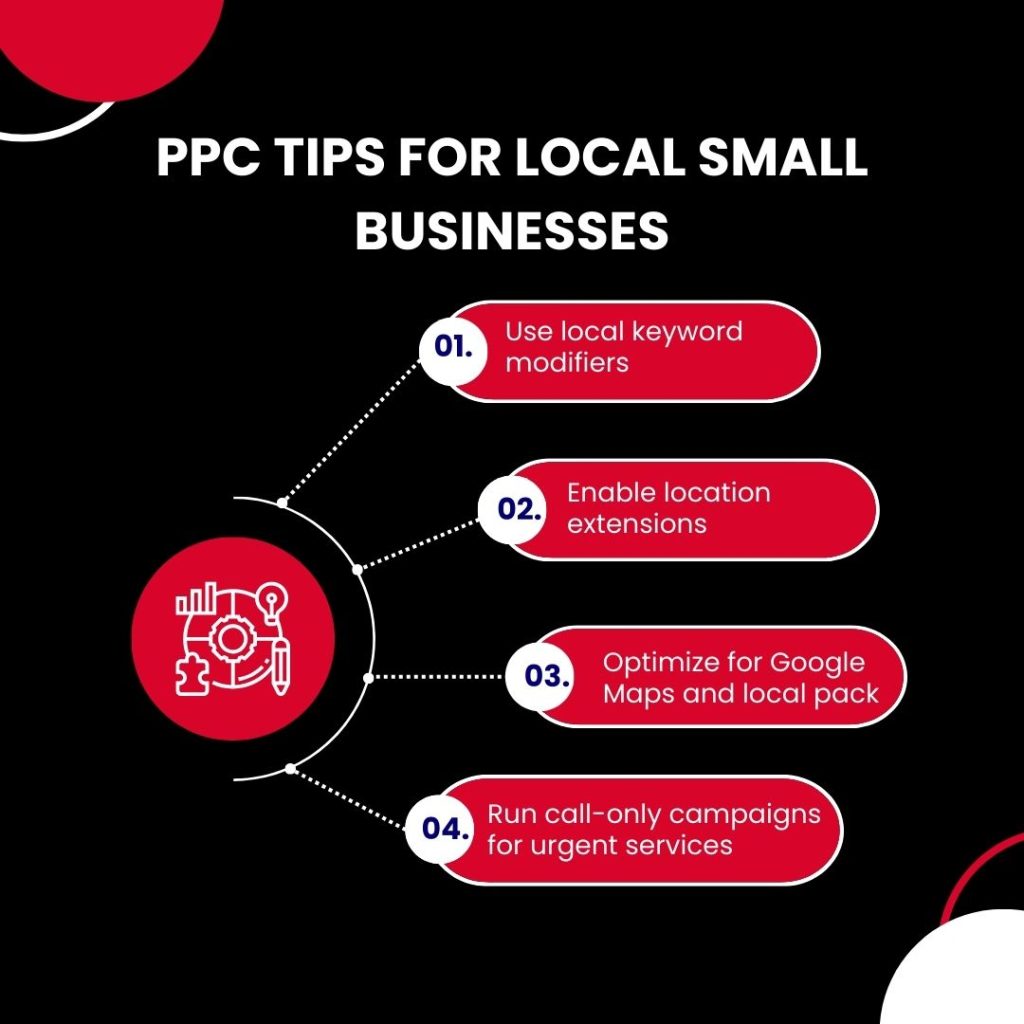
To succeed locally:
- Use local keyword modifiers: Searchers often include terms like “near me” or specific city names. Phrases like “emergency plumber in East Hanover NJ” or “best pizza near Roseland” drive highly qualified traffic.
- Enable location extensions: These show your business’s address and map location right within the ad, increasing the likelihood of in-store visits or local service calls.
- Optimize for Google Maps and local pack: Ensure your Google Business Profile is complete, accurate, and consistently maintained so your PPC efforts reinforce your local organic presence.
- Run call-only campaigns for urgent services: If your business depends on fast calls—like HVAC, towing, or home repair—call-only ads can convert mobile searches directly into leads.
For Subscription-Based Ecommerce
PPC for subscription businesses must balance cost per acquisition (CPA) with lifetime value (LTV). While the goal is to get users to subscribe, the real payoff comes from retaining them over time.
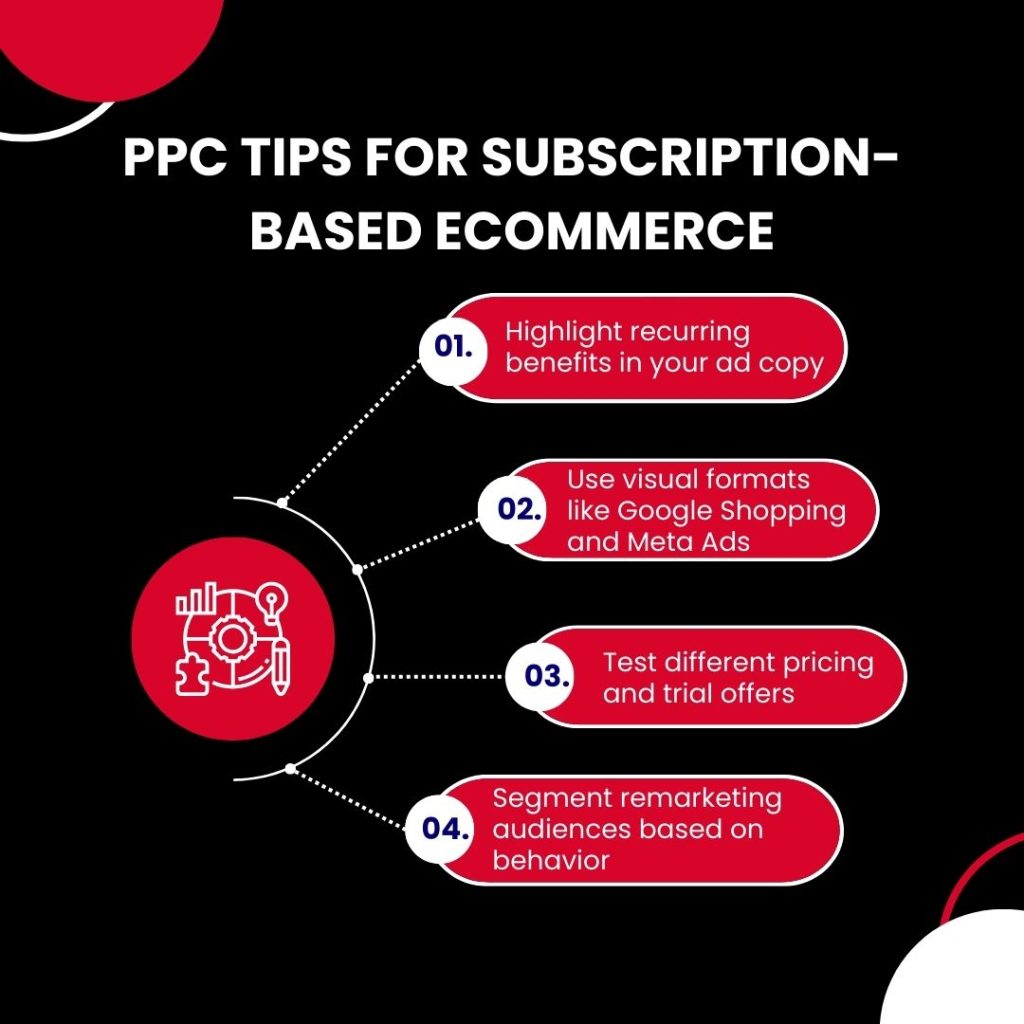
To make PPC work for subscriptions:
- Highlight recurring benefits in your ad copy: Reinforce what the user gets month after month, whether it’s convenience, cost savings, or exclusive access.
- Use visual formats like Google Shopping and Meta Ads: These help showcase product benefits and lifestyle appeal, which is critical for subscription boxes and wellness products.
- Test different pricing and trial offers: Free trials, discounted first boxes, or bundled offers can increase conversion rates for new subscribers.
- Segment remarketing audiences based on behavior: Serve different messages to one-time visitors, cart abandoners, and past subscribers to increase retention and reactivation.
For Law Firms and Medical Practices
These industries require precision and sensitivity. The stakes are high, and the trust factor is critical. PPC in this space must build credibility while targeting users at key moments of need.
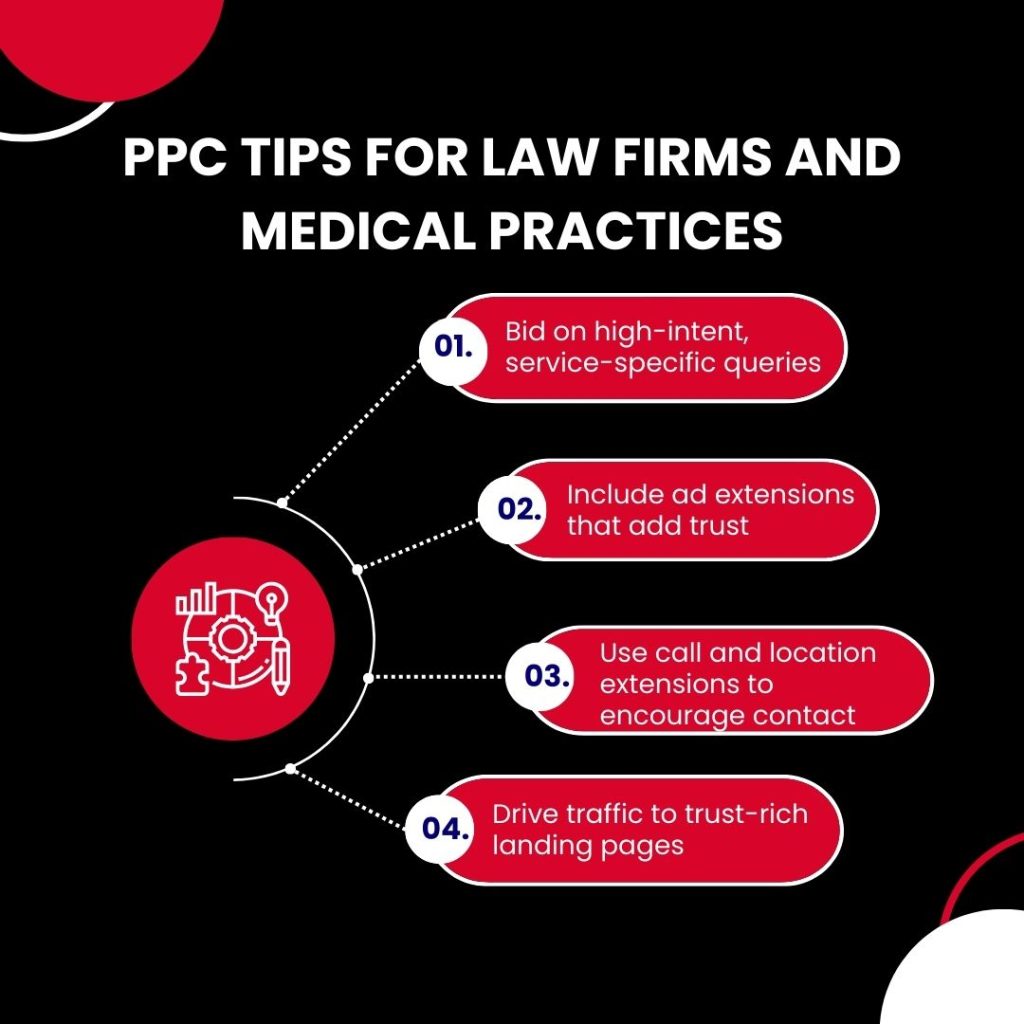
To execute PPC for professional services:
- Bid on high-intent, service-specific queries: Keywords like “workers’ comp lawyer in Middlesex County” or “orthopedic surgeon accepting new patients” reflect immediate needs.
- Include ad extensions that add trust: Sitelinks to reviews, attorney bios, or accepted insurance pages can significantly boost CTR.
- Use call and location extensions to encourage contact: These make it easy for mobile users to act quickly—especially important for urgent care, dental emergencies, or legal consultations.
- Drive traffic to trust-rich landing pages: Incorporate testimonials, case studies, bar or board certifications, and clear CTAs to reassure and convert new clients.
Whether you’re in hospitality, healthcare, legal, or ecommerce, industry-specific PPC campaigns require a tailored approach that aligns with how your audience searches, evaluates, and decides. At NetLZ, we specialize in customizing campaigns to fit the nuances of your market.
It’s also important to consider how PPC and SEO complement each other. SEO offers sustainable traffic growth over time but requires patience, content investment, and algorithmic resilience. PPC, on the other hand, delivers fast, targeted results and is easier to scale or pause as needed.
Which should you prioritize? If your goal is immediate visibility or testing new campaigns, PPC should come first. For long-term cost savings and brand authority, SEO is essential. Most high-growth businesses benefit from a hybrid strategy—using PPC to drive short-term ROI and SEO to build long-term momentum.
Why Partner with NetLZ Consulting?
Choosing the right PPC partner can make all the difference. It’s the gap between running ads that simply spend money, and campaigns that drive real business growth. At NetLZ, we bring a results-first approach rooted in strategy, data, and a deep understanding of digital ecosystems.
Our PPC services include:
- Comprehensive campaign setup and daily management
- Performance-driven landing page design and split testing
- Detailed conversion tracking with actionable analytics
- Transparent reporting with clear KPIs
Beyond PPC, we offer a full suite of solutions—including SEO, web design, and social media marketing—to support your growth from every angle. Whether you’re a local business or scaling nationwide, our team customizes campaigns to deliver the results that matter to you.
Maximizing PPC ROI: The Bottom Line
To increase PPC ROI, businesses must go beyond basic ad creation. The real wins come from strategic planning, ongoing optimization, and integration with a broader digital ecosystem.
Whether you’re a startup or an established company, PPC can accelerate growth if done right. At NetLZ, we tailor our approach to your goals and market so that every click counts.
Let’s build your next high-performing campaign together.

